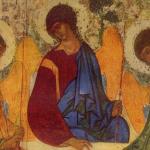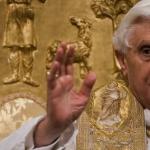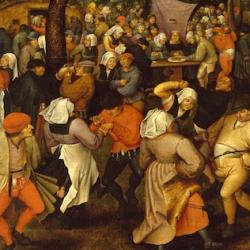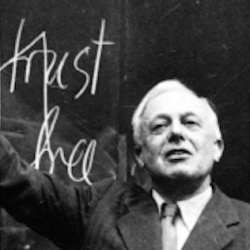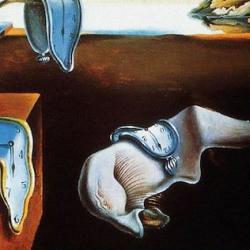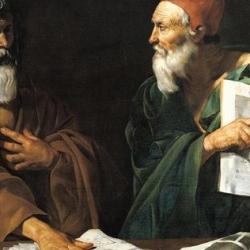Dead time, Rosenstock-Huessy says, is entirely a product of the past, a result of a cause. That conception of time works for physics, but it fails to account for the reality of human time, which always involves surprise and a break with the past. Through speech, we initiate new times, and through speech we bring a new future.
Future, in fact, is not merely what lies ahead, but specifically a “break with the past”: “That which simply goes on from the past as a trend is not ‘future’ in the fullest sense of this term. It simply travels on an extension visa from the past. In human history the break with the past is the condition of any future. The relation of any past event and any future is never made by a trend, but always by a victory over trends” (Christian Future [CF] 32).
The future doesn’t just come; it has to be “created” (CF, 33), and it has to be created through struggle. We only make future as we fight against the trends of the past. In short, “future means novelty, surprise; it means outgrowing past habits and attainments” (CF 61).
Future is the creation of Christianity and the Christian era, and this is so because Christianity puts death and resurrection at the center of its creed: “Christians believe in an end of the world, not only once but again and again. This and this alone is the power which enables us to die to our old habits and ideals, get out of our old ruts, leave our dead selves behind and take the first step into a genuine future.” Rosenstock-Huessy goes so far as to say that “Christianity and future are synonymous” (CF 63-64).
Through creating future, a common future, Christianity also created the possibility of a unified human race. The church entered a “world of divided loyalties – races, classes, tribes, empires, all living to themselves alone.” Jesus did not destroy these pre-existing loyalties, but fulfilled them: “by a gift of a real future, Christianity implanted in the very midst of men’s loyalties a power which, reaching back from the end of time, drew them step by step into unity” (CF 62).
Pagan thought means “disunity, dividedness of mankind,” and this dividedness is as much temporal as spatial. Pagans never arrived at a view that history was one; each history instead begins and ends something “within time,” and so “pagan thought almost universally pictures human life as a decline from a golden age in the past toward ultimate destruction in the future” (CF 63).
This tragic view of time can do no more than cultivate virtues of endurance: “it faces the world with prudence and courage; it is grounded in the facts of experience.” But paganism cannot produce faith, hope, and love. This is because paganism “lacks future,” and also because paganism leads to a lack of future.
The key issue is the view of death: “Myths arose to conceal death in the past as well as in the future” (CF 65). Men are born into families, clans, countries, but it’s obvious that each of these forms dies. Myth is the effort to screen off the fear of death in the future (CF 64). Myths also veil the realities of death in the past. For ancient cities and tribes, blood guilt “lay about their origins,” and therefore myths “were built on a phase of experience which was repressed and left nameless, an ineffable gap” (CF 65).
Paganism pretends that something in this world is permanent, and myths attempt to enclose some particular tribe in a permanent time and place that cannot be touched by death. Myths claim that THIS tribe is uniquely connected to the universe, and therefore eternal (CF 64).
Instead of putting the fall in some mythological and inaccessible past, Christianity placed it in time: “in place of a pedigree from a mythical ancestor it put original sin inherited from Adam. And resolutely, it began in the midst of time, not in a mythical fog. Against all deathless myths and hopeless cycles the price of a living future is to admit death in our lives and overcome it. This is the supreme gift of Christianity; it showed that the fear of death need not force man into the narrow circle of any given community.” Thus, “instead of pagan dividedness it created a universal pedigree for man that transcends the partial ends and beginnings, and measures history from the end of time” (CF 65).
In this, the Christian era was prepared by the history of Israel. Instead of opening with a mythology in which heaven and earth are separated, with gods presiding in each divided locale, the Hebrew Bible begins with a union of heaven and earth, united by the creating power and Word of the One God.
Genesis 1:1 was “spoken into a world in which celestial gods had sanctified the divisions of lands on earth by their various myths for each locality, a world in which the separation of heaven and earth, of land and land, nation and nation, was the accepted reality. Against the thousands of elohims, inspiring mythical heroes, One is God” (CF 65).
In place of the veiled beginnings of pagan myths, the Bible laid out the “chain of unspeakable crimes – like the murder of Abel by Cain – which had torn the unity of mankind.” Above all, Israel found behind all human divisions “the One God, who did not share the man-made divisions. In Him the end of humankind, to live as one in peace, became known as the oneness already guaranteed in the creation of Adam” (CF 66). Hence, the Jews are the great “living witnesses to the truth which has to be suppressed whenever a myth is to be woven” (CF 66).
Building on the inheritance and foundation laid in Israel, Jesus “created man’s future.” Israel’s work was to “establish the unity of heaven and earth, man and woman, brother and brother, father and son.” Jesus opened ‘a new dimension: Creation of a new man by letting the pagan and Jew survive themselves.” He is the “perfect man, the first complete human being” because he “overcame man’s dividedness by living once for all the specific law of the human kind, namely, that man can progress from fragmentariness to completeness only by surviving the death of his old Adam, his old allegiances, and beginning new ones.”
No ancient man “survived himself completely” or “shed his nationality, clan or city” in a way that this process of shedding the past became the “theme of his whole life and made others succeed him in this conversion.” Jesus did, and thus “proved that every end could and should be turned into a new beginning, that even absolute failure and death could be made fertile” (CF 66).
This is not only about the positive incorporation of death into life, the seed planted and dead that brings forth fruit. It also means that Jesus created the possibility of contact between soul and soul: “Jesus opened in all of us avenues for contact between ourselves and everybody else. Death became a carrier of life between souls” (CF 67).
What Rosenstock-Huessy seems to mean here is that Jesus’ life surpassed the deaths that divide generation from generation, man from man. Jesus dies to all things in His death, and yet arises again. By rising again, he incorporates all that preceded Him into a new life.
In another section of The Christian Future, Rosenstock-Huessy describes Jesus’ creation of future in somewhat different terms. Every generation, granted, has to live for itself, “in the spirit of their time,” but without something that brings unity to the ages, “there still would be the arrogance and the disloyalty and the indifference of the last generation towards all the previous.”
Jesus put an end to “this ceaseless splitting into new beginnings”: “After all these ‘afters,’ all these juvenile ‘waves of the future,’ the mere beginner would still have to be converted into the son and heir of all times.” Through this kind of “conversion,” the seed of a “convergence of all generations” was planted. Jesus “embedded all times, including his own, in one suppertime, one eternal present” (CF 189).
All men are on the cross, torn in pieces, but “together we may look for a suppertime, for the fellowship in which we can relieve each other’s crucial split by solidarity.” Through fellowship among generations, man “can come home.” Supertimes are created by “the faith of every generation,” and this faith is “the simple application of the principle of unlocking the doors between the times as practiced by Jesus first” (CF 189).
The whole idea of the “Christian era,” Rosenstock-Huessy claims, is the declaration that “Now is the time” and that “today these prophecies are fulfilled in your hearing”: “Jesus became the center of history by being the human soul made visible, the Messiah whom the Jews expected only at the end of history. In this way he introduced the end of time as a directing force in the present. Whereas the Jews identified end and beginning in God and virtually ignored everything in between, Jesus created a historical process in which every year, every day, every present is equally immediate to God because it is equally a meeting point for all the imperfect past and perfecting future. In Jesus the beginnings of antiquity all come to an end and all the ends of modern man make their beginning; the promises of old, to all the nations, are not turned progressively into realizations” (CF 190).
Death and resurrection made Jesus “Founder of the Messianic kingdom.” Only by death could He transcend the “old Law” and the responsibilities of a mere child of Abraham. He had only His death “to invest in the future, and his great discovery was that the true future is opened up by the power that survives death. In revealing this power he created man’s perfect plasticity on the forward front, his ability to begin anew each day like a new-born child. He redeemed mere birth by revealing it as the fruit of death” (CF 190).

